Razafitsiferana Théophile, Bruno Razanamparany, Mahandrimanana Andrianainarivelo
Universite Antsiranana Mention Chimie Minerale, Madagascar
Correspondence to: Razafitsiferana Théophile, Universite Antsiranana Mention Chimie Minerale, Madagascar.
| Email: |  |
Copyright © 2017 Scientific & Academic Publishing. All Rights Reserved.
This work is licensed under the Creative Commons Attribution International License (CC BY).
http://creativecommons.org/licenses/by/4.0/

Abstract
Nosy-Be, an Island situated to the Northwest of Madagascar, she/it is possessed of the underground waters. This work has for objectives; the determination of physico-chemical, microbiological parameters and the verification of the conformity of the values found in relation to the international norms. The gotten results permitted to note that the values of the physico-chemical and microbiological parameters are in conformity with the international norms.
Keywords:
Water, Physico-chemical and microbiological parameters
Cite this paper: Razafitsiferana Théophile, Bruno Razanamparany, Mahandrimanana Andrianainarivelo, Physico-Chemical Analysis of the Water of the Well of Ampombilava in the District of Nosy-Be, Resources and Environment, Vol. 7 No. 3, 2017, pp. 81-86. doi: 10.5923/j.re.20170703.03.
1. Introduction
The urban township of Nosy-Be includes an archipelago of is lets scattered, that is situated in the channel from Mozambique to the Northwest of Madagascar, between 13°11' and 13°30' of latitude South and between 48°22' and 48°8' of longitude is. Nosy-Be has a large container of water for the one that the population makes wells in the city of Nosy-Be or outside. This search takes place on the well of Ampombilava.The objective of this work is to know their physicochemical characteristic of the water of the well of Ampombilava and microbiological.The present invention comprises four parts, the first of which contains the bibliographic synthesis, the second contains the results of measurement for the physico-chemical and microbiological analyzes, the third part concerns the discussion and one ends with a conclusion.
2. Synthesis Bibliographic
I / - Ownership of waterThe structure of water depends on its essence, liquid and solid. The sparkling state corresponds exactly to the formula H2O.II / - Chemical properties of waterThe energy of the formation of the water molecule is 242 KJ / mols. The first possible operation with water is the dissociation of an H + proton and an ionic OH hydroxide. The separation of the two ions attacks the pH (potential of hydrogen), the scale is from 0 to 14.III / - Chemical composition of waterWater is a gaseous dissolution of oxygen and carbon dioxide, but it contains nitrogen and methane.The water contains several mineral substances, their concentrations vary in mg / l.The metalatexist in water itself presents as trace like Ironic, Lead .........The organic materials can be represented in dissipated form.Microbiological pollution also exists in water, such pollution may be due to theft of pipelines or others to the use of several insecticides.IV / - Norm of quality1 - Recommendation of the WHO 2 - Recommendation of EU 3 - Recommendation of the EM Recommendation of the WHO
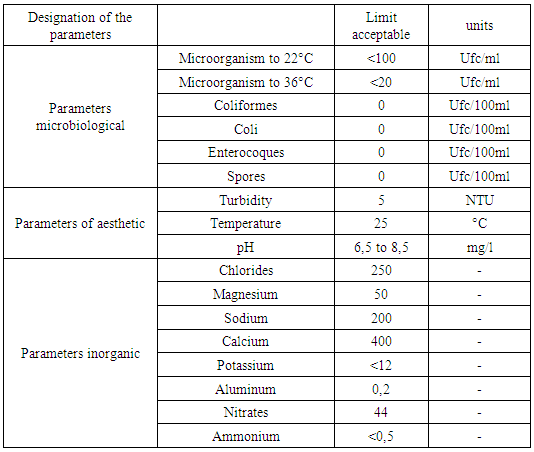 |
| |
|
Recommendation of the EM
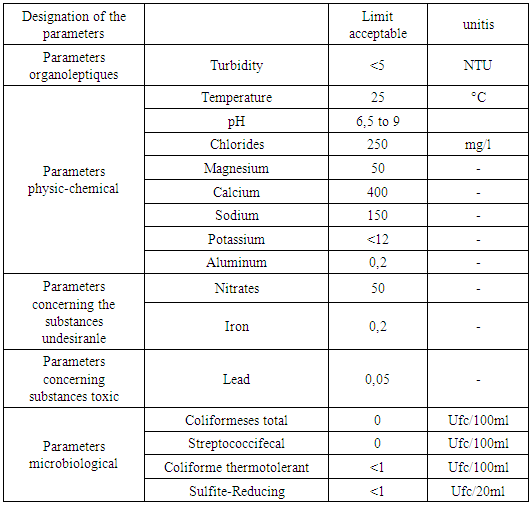 |
| |
|
Recommendation of the EU
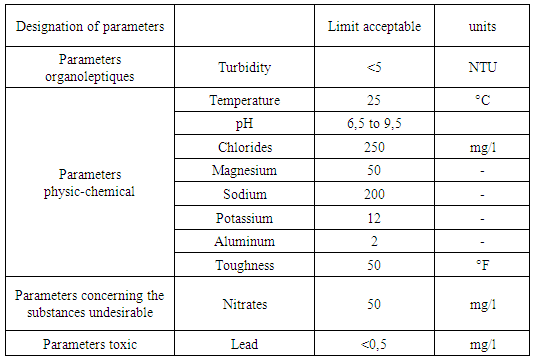 |
| |
|
3. Parameters of Analyses
- Turbidity: the turbidity is the representation of the transparency of a water. The turbidity is an important parameter in the different norms fixing the quality of the drinking waters.- The pH: the pH permits to know the potential of water hydrogen, to know if one is in one the three zones next one: either alkali the pH>7, neutral if the pH=7 and acidicif the pH <7. - Toughness: the toughnessis the set of the two ions that and Mg it is called as calcictoughness and magnésienne. - Iron: ironis an essential element of the human nutrition, the dailyneedis from 1 to 2 mg. - The chloride: the chloride one of ion classified as the major ion contained in the natural water, their contents are varie dextremely. - The nitrates: as derivative salt of the nitricacid, they are used in agriculture as manure and are very water soluble. - Sodium: is the person responsible of the electrolytic hydro balance in the human body. - Lead: it is a heavy and toxicmetal, their existence in the drinking water is not admissible according to the international norms. - Aluminum: is among the heavy metals, their existence in water is very dangerous.
4. Results of Measures
I / - physical Parameters1 - Temperature
 |
| |
|
2 - The turbidity
 |
| |
|
3 - Measure pH
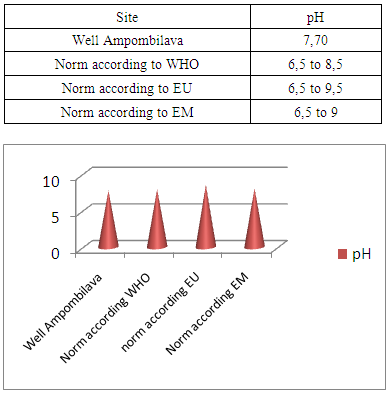 |
| |
|
II – Chemical Parameters1 - The saltiness
 |
| |
|
2 - Dosage of the nitrates
 |
| |
|
3 – Sodium
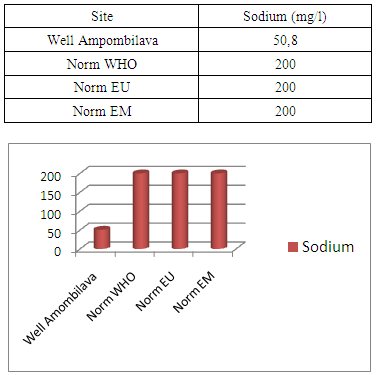 |
| |
|
4 - Potassium
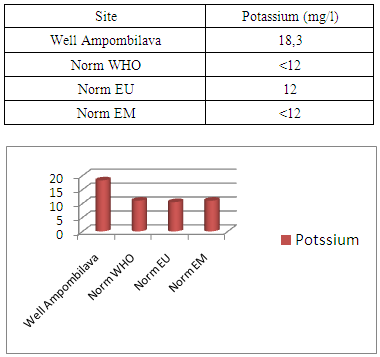 |
| |
|
5 - Calcium
 |
| |
|
6 - Magnesium
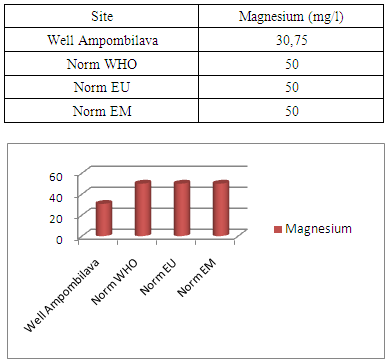 |
| |
|
7 - The total toughness
 |
| |
|
8 - Aluminum
 |
| |
|
9 - Lead
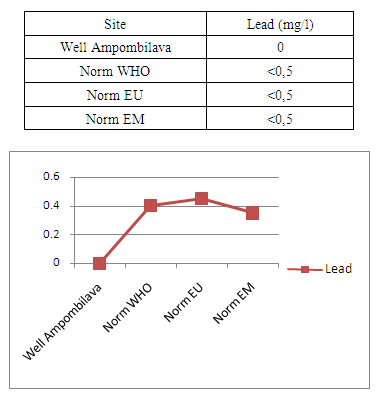 |
| |
|
10 - Dosage of the chloride
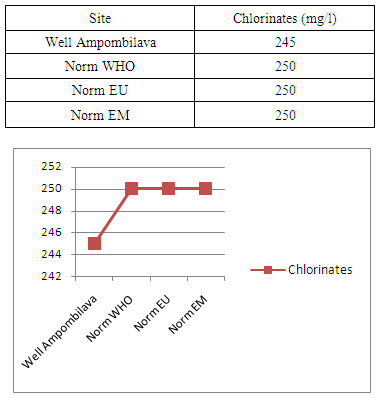 |
| |
|
11 - Dosage of the total iron
 |
| |
|
III / - Analysis bacteriological
 |
| |
|
5. Discussion
I / - The physical parametersIn general, the values found in the physical parameters are nearlyadmitted in relation to the international norms as the temperature, the turbidity and the pH.II / - The chemical parametersChemically, the concentrations found in this analysis are in particular admissible to the international norms the concentration of calcium is verylow in relation to the required value, while the concentration of potassium is raised toomuch. The water of well of Ampombilava say very because they found concentration is four times the normal value to the international norms. III / - bacteriological AnalysisTo the bacteriological level, the values found in this analysis are admitted to the international norms, the water of the Well of Ampombilavais not microbial, there foreitis good.
6. Conclusions
The physicochemical parameters of the Ampombilava well correspond to 95% of the values required for international standards. The bacteriological concentration accurately reflects the values required for the three international standards. Therefore, the water in the Ampombilja well is potable despite the inadequacy of certain concentrations in calcium and sodium.
References
| [1] | CODE DE L’EAU MALGACHE, loi 98-029 promulgué le 20 janvier 1992. |
| [2] | ORGANISATION MONDIALE DE LA SANTE (OMS) Directive de qualité pour l’eau de consommation volume I, II, Bénie, 1994 p.49 et p. 85. |
| [3] | DECRET n° 81- 324 du 03- 01- 89 relatif aux « eaux destinées à la consommation humaine à l’exclusion des eaux minérales naturelles » J.O. de la République Française 04. 04. 89. |
| [4] | G. VIVIN (février 1957). Mesure et régulation du pH. Génie Chimique, 37. |
| [5] | W.F. LANGELIER (1946). Effect of temperature on the pH natural waters J.A.W.W.A.38.p.179. |
| [6] | C.I. LUKE, K.C. BRAUN (1952). Photometric determination of Aluminum. |
| [7] | J.RODIER (1952). Détermination de la dureté dans les eaux par la méthode au complexon III. |
| [8] | H. KATZ, R. NAVONE (1964). Method for simultaneous of calcium and magnesium J.A.W.W.A, I, p.56. |
| [9] | R. PINEL. (1991). L’analyse des organométaliques en traces dans l’eau: Mercure et Plomb, Analusis (Paris), 19,2. |
| [10] | F.E. CLARKE (1950). Detremination of chloride in water, An Chem, 22.p.553-1458. |



 Abstract
Abstract Reference
Reference Full-Text PDF
Full-Text PDF Full-text HTML
Full-text HTML
















